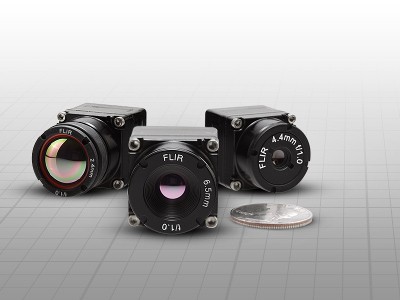
 This week at the SPIE Defense and Commercial Sensing Conference in Baltimore, Oregon’s FLIR Systems, Inc. (NASDAQ: FLIR) unveiled its small, lightweight uncooled thermal camera core, called Boson, which boasts a low-power 12-core vision processor running FLIR XIR expandable infrared video processing architecture.
This week at the SPIE Defense and Commercial Sensing Conference in Baltimore, Oregon’s FLIR Systems, Inc. (NASDAQ: FLIR) unveiled its small, lightweight uncooled thermal camera core, called Boson, which boasts a low-power 12-core vision processor running FLIR XIR expandable infrared video processing architecture.
FLIR’s night vision technology has been powering automotive thermal cameras for BMW and Audi for several years now, but the Boson’s combination of size and image processing capacity aligns the product well with expanding markets like autonomous cars, wearable cameras, surveillance, and the Internet of Things.
Back in 2012, FLIR Systems acquired Markham, Ontario-based video surveillance company Lorex Technology and folded key components of its night-vision and monitoring capabilities into its own product.
Lorex branded home monitoring camera systems are still offered through FLIR.
“Boson represents a significant advancement in size, weight, power and cost for small high-performance microbolometer-based cameras,” said FLIR President and CEO Andy Teich. “As the market demand for affordable and smaller sized camera cores strengthens, we continue to drive technical breakthroughs that enable high performance sensing at lower costs to produce. We’re excited to introduce Boson into our family of cores and to offer a broader range of configuration options to OEMs that will help them expedite development and lower their cost-to-market.”
Thermal cameras are finding uses in everything from maritime rescue drones to helping preservationists protect rhino populations.
The Boson camera core uses the Myriad 2 chip from Irish company Movidius, and features a 12-micron pixel pitch detector, with several levels of video processing, including visible CMOS imaging sensors, GPS and Inertial Measurement Units, and a suite of image processing features related to resolution, image blending and noise reduction.
This chip integration puts the Boson into the trending System-on-Sensor category, which means that image processing can be accomplished in real time and directly in the sensor, without the need to export to third-party image processing platforms.
Although the Boson is on display now at the SPIE Defense and Commercial Sensing Conference, FLIR is also making it available to original equipment manufacturers for product development testing.
Thermal cameras are finding uses in everything from maritime rescue drones to helping preservationists protect rhino populations. A company called Axis Communications recently donated thermal cameras to the Thaba Manzi Wildlife Services sanctuary in Limpopo, South Africa. Footage of some would-be poachers recently went viral after the sanctuary installed 24-hour surveillance.
“We have had a lot of incursion attempts before. It’s already an expensive and difficult challenge to help the rhino recuperate from attacks, so every effort helps – and these cameras will help a lot,” Dr. Jana Fourie, founder of the Rhino Pride Foundation, a group that provides support to the sanctuary, said.
Thermal cameras differ from the popular images of infrared imagery that are known for their greenish hue, indicating the presence of a low-level of light. Thermal cameras simply indicate changes in temperature and have the ability to “see” in total darkness.
Below: FLIR Boson Thermal Core with Movidius Myriad 2
https://www.youtube.com/watch?v=hsopAM8FexE&feature=youtu.be
Leave a Reply
You must be logged in to post a comment.



 Share
Share Tweet
Tweet Share
Share




Comment